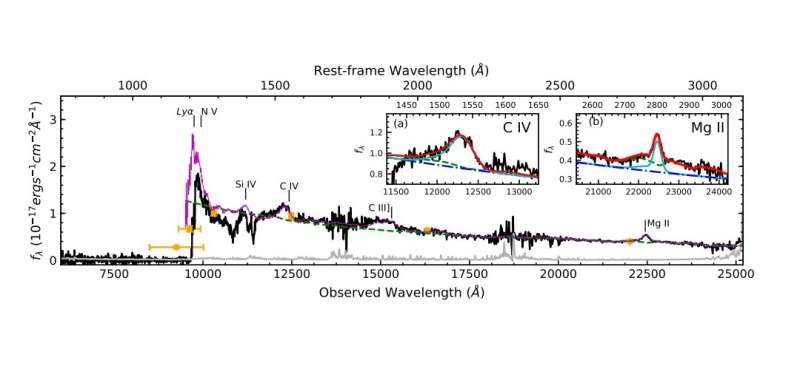November 6, 2018 report
Astronomers discover new luminous high-redshift quasar

An international team of astronomers has detected a new luminous quasar at a redshift of 7.02. The newly found quasi-stellar object (QSO), designated DELS J003836.10–152723.6, is the most luminous quasar known at a redshift of over 7.0. The discovery is reported in a paper published October 29 on the arXiv pre-print repository.
Powered by the most massive black holes, bright quasars at high redshift are important for astronomers as they are perceived as the brightest beacons highlighting the chemical evolution of the universe most effectively. They are the most luminous and most distant, compact objects in the observable universe and their spectrum can be used, for instance, to estimate the mass of supermassive black holes (SMBHs).
However, high-redshift QSOs are extremely rare and difficult to find. So far, only two quasars with redshifts over 7.0 have been identified. This limits our understanding of SMBH growth mechanism and reionization history.
Now, a group of researchers led by Feige Wang of the University of California, Santa Barbara (UCSB) announced the finding of a new quasar with a redshift above 7.0. The new discovery is part of the team's ongoing search for distant quasars and was made using photometric data from the DESI Legacy Imaging Survey (DELS), Pan-STARRS1 (PS1) imaging survey, as well as Wide-field Infrared Survey Explorer (WISE) mid-infrared all-sky survey.
"In this letter, we report the discovery of a luminous quasar at z = 7.021, DELS J003836.10–152723.6 (hereafter J0038–1527)," the astronomers wrote in the paper.
The team found that DELS J003836.10–152723.6 has an absolute magnitude at rest-frame wavelength 1450 Å of –27.1 and a bolometric luminosity of about 56 trillion solar luminosities. These values make it the most luminous quasar with a redshift of over 7.0 known to date.
According to the paper, DELS J003836.10–152723.6 hosts a black hole with a mass of around 1.33 billion solar masses. This black hole is accreting at the Eddington limit, with an Eddington ratio of 1.25. The researchers added that in order to grow such a massive black hole at a redshift or around 7.0, it is necessary to have either massive seed black hole, or episodes of super-Eddington accretion, or a very low radiation efficiency.
"The existence of such SMBHs at EoR [epoch of reionization] requires either massive seeds or episodes of super-Eddington accretion under a typical radiation efficiency of about 0.1. Otherwise, the radiation efficiency must be much lower than that for thin disk accretion," the paper reads.
Furthermore, the astronomers found that the Civ broad emission line of this quasar is blue-shifted by more than 3,000 km/s to the systemic redshift. The study also revealed three extremely high velocity Civ broad absorption lines (BALs) with velocity from 0.08 to 0.14 times the speed of light and total balnicity index of more than 5,000 km/s, which is indicative of the presence of relativistic outflows in the quasar.
The authors of the paper concluded that the findings make DELS J003836.10–152723.6 the first quasar found at the epoch of reionization with such strong outflows. Hence, the newly detected quasar could be an excellent target for future deep X-ray and (sub) millimeter observations aimed at studying active galactic nuclei (AGN) feedback on the formation and growth of the most massive galaxies in the early universe.
More information: Feige Wang et al. The Discovery of A Luminous Broad Absorption Line Quasar at A Redshift of 7.02. arXiv:1810.11925 [astro-ph.GA]. arxiv.org/abs/1810.11925
© 2018 Science X Network



















